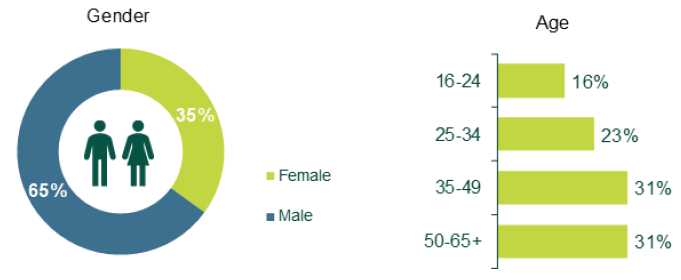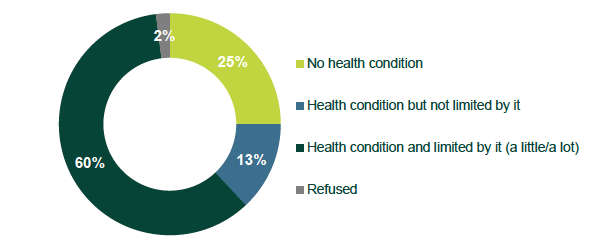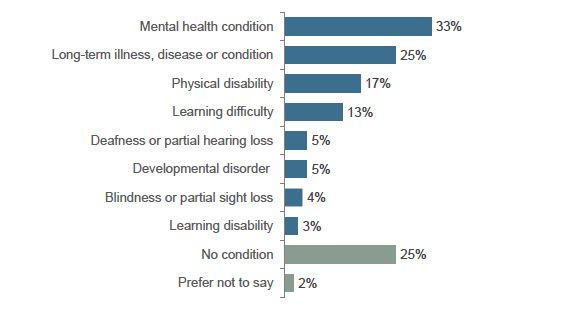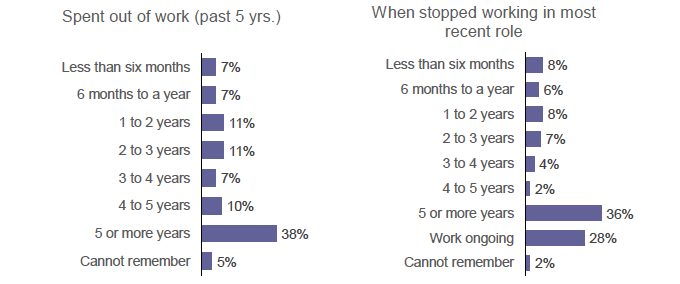Fair Start Scotland evaluation report 2: participant phone survey - November 2019
Part of a series on the evaluation of Fair Start Scotland employability services. It presents more detailed findings from a representative telephone survey of FSS participants and explores their experiences in the first year of service delivery (Apr 18 to Mar 19).
2. Profile
In this chapter we provide an overview of the characteristics of participants of the FSS service. We begin by looking at demographics such as age, gender and health condition, and in the second part of the chapter we describe participants' work status and history. Demographic data was gathered from the service provider where available, and asked in the survey for participants only where data was missing.The responses were weighted to reflect the gender, age and FSS Service Lot of all participants who have joined the FSS service between April and December 2018.
2.1 Participant profile
Age and gender
A challenge for FSS was to engage more women and older people in the service than their preceding services, Work First Scotland and Work Able Scotland, which had proportionately more men and young people participating[1]. FSS Scotland achieved a fairly even spread across age groups from 16 to over 65 year olds, however the proportion of men taking up the service was still higher than women, with 65 per cent of participants identifying as male, and 35 identifying as female (as illustrated in Figure 2.1 below).
Two-fifths (38%) of FSS participants were aged under 35, with 31% falling into each of the 35-49 and 50 or over age brackets. The gender profile of respondents did not vary by age.
Figure 2.1: Gender and age of FSS participants

Source: Sample information, H1: Do you identify as…?, H2: Which of the following age bands do you fall into? Base: All respondents (1005)
Forth Valley (Lot 4) were the only Lot who achieved a significantly more even gender split than the others; 54 per cent of their participants were male and 46 per cent were female.
The age make up changed slightly for those receiving In-work support, where there was a higher proportion of 16-24 year olds (22 per cent compared to 14 per cent of those receiving pre-employment support), and a lower proportion of older people over 50 years old (25 per cent compared to 32 per cent).
Qualifications of participants
Over half of FSS participants had achieved qualifications equivalent to National 1-5 or higher (57 per cent), while 14 per cent did not have any formal qualifications, as illustrated in Figure 2.2.
Figure 2.2: Qualifications achieved by FSS participants

Source: H3: What is the highest level of qualification that you have achieved? Base: All respondents (1,005)
Four out of five (79 per cent) participants between 16-34 years old held qualifications equivalent to at least National 1-5. This compares to just three in five participants who were aged over 50 or over (59 per cent).
Older participants were more likely to have no qualifications than any other age group (21 per cent of over 50 year olds had no qualifications compared to just seven per cent of 16 to 34 year olds).
Disability status
The majority of participants in the FSS service reported having a health condition which restricted what they could do. As illustrated in Figure 2.3 below, nearly three quarters (72 per cent) of FSS participants had at least one long term health condition or disability, and for 60 per cent of participants their condition limited their ability to carry out day-to-day activities.
Figure 2.3: Health status of FSS participants

Source: Sample information H4i: Do you have any of the following conditions which have lasted, or are expected to last, at least 12 months? H4n: Does your health or disability limit your ability to carry out day-to-day activities? Base: All respondents (1,005)
One quarter (25%) of participants did not have any health condition. This proportion was fairly consistent across other demographic groups but increased to nearly half in Glasgow (48 per cent of participants in Lot 1 had no health conditions).
A third of participants (33%) said they had a mental health condition, whilst a quarter (25 per cent) said they had a long-term illness, disease or condition and a fifth (17 per cent) reported having a physical disability.
A significant proportion of participants (13 per cent) also reported having a learning difficulty such as dyslexia, while a range of other condition types were experienced by 17 per cent of participants. Figure 2.4 shows the full range of disability types reported by participants.
Figure 2.4: Any health conditions experienced by FSS participants

Source: H4i: Do you have any of the following conditions which have lasted, or are expected to last, at least 12 months? Base: All respondents (1,005)
Over half of all participants only had one condition (56 per cent) while a small proportion (16 per cent) had more than one. Further analysis of different condition types and their impacts on participants can be found in chapter 6.
Length of time receiving FSS service
We surveyed participants who had started the service between March and December 2018. Nearly half of participants (46 per cent) were not receiving support from FSS at the time they were interviewed (June 2019). This included 49 per cent of participants who were previously receiving Pre-Employment Support and 35 per cent who were receiving In-work support. Further information about why participants left the service can be found in section 4.3.
Employment history
Figure 2.5: Duration of time spent out of work over last five years and length of current period of unemployment

Source: B3: In total over the past 5 years prior to receiving support through the Fair Start Scotland service approximately how long have you spent out of work? B4: How long ago did you stop working in your most recent role? Base: All respondents (1005)
Two-fifths (38%) of participants had spent five or more years out of work before joining the Fair Start Scotland service.
Those with a higher level of education were more likely to have been in work at some point in the last 5 years, and those with no formal qualifications were more likely to have been out of work for 5 or more years (54% compared with 24% of those educated to degree level). Furthermore, those with Highers or equivalent (10%) and those with a degree level qualification or above (13%) were more likely to have spent less than six months out of work in the last 5 years than those with lower levels of educational qualifications (Nationals 1-5, 6%; no qualifications, 3%).
Those from Tayside (Lot 3) reported a shorter average duration of unemployment over the last five years; 24% of participants in this area had only been unemployed for six months or fewer before FSS, in comparison to an average of 11% in other areas.
Respondents in older age groups were more likely to have been out of work for more than 5 years prior to accessing FSS services than those in younger age groups (44% of those aged 50 or over; 39% of those aged 35-49; and 32% of those aged 16-34).
Contact
Email: kirstie.corbett@gov.scot
There is a problem
Thanks for your feedback